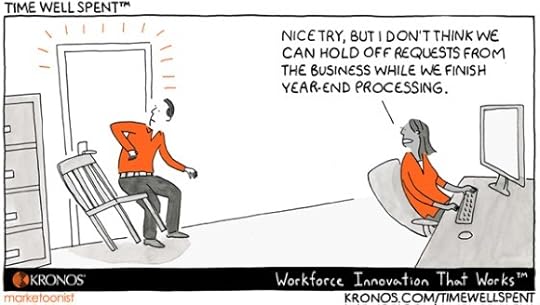Sharlyn J. Lauby's Blog, page 144
January 13, 2017
Quick Shots for #HR and #Business Pros – Goals Edition

There’s a statistic that only 8 percent of people actually achieve their New Year’s Resolutions. I happen to think part of the reason is because people don’t set good goals in the first place. Here are some resources to help you set better goals in 2017.
“How to Set Relevant Goals” shares some resources for starting off with achievable goals.
And “3 Types of Goals You Should Set” reminds us that all plans and objectives are not created equal.
“Are Learning Goals Better Than Performance Goals” focuses on another aspect to goal-setting that’s really important – goal priorities.
I’m a big fan of S.M.A.R.T. goals. Here’s an article on how to use them for goals, projects, and meetings.
Once you create a goal, staying focused is a challenge. There’s always some shiny, new thing that can distract us. “Use Gumby to Keep Employees Focused on Goals” might encourage you to keep a green clay figure on your desk.
There are several ways to track goal progress. “Work Journals Help Employees Accomplish Their Goals”
Finally, remember that the conversation about goals isn’t only for individuals. Businesses need to be good at goal setting as well. Check out “Why OKRs Are Going Mainstream in Business” to see how you can use the methodology of Objectives and Key Results (OKRs) to turn plans into reality.
So much of our work is attached to goals. Being able to set, manage, change, and evaluate a goal is key to our success. The good news is that goal setting isn’t a one-size-fits-all activity. You (and your organization) can find the process that works best.
Image taken by Sharlyn Lauby after speaking at the Healthcare Human Resources Association Conference in Stillwater, MN
The post Quick Shots for #HR and #Business Pros – Goals Edition appeared first on hr bartender.






January 12, 2017
The Impact of Impression Management on Personal Branding
I love getting questions from HR Bartender readers. This one was a bit challenging.
What is the link between personal branding and impression management? I am working on a research project and need to know the connection between them. I hope you could answer my question. Thank You.
I must admit, I had not heard of the term “impression management” before, so I Googled it and found that Impression management, first conceptualized by Erving Goffman in 1959, is a conscious or subconscious process in which people attempt to influence the perceptions of others about a person, object, or event. They do so by regulating and controlling information in social interaction. An example would be in a sport such as football. A player wants to highlight themselves in the best possible way, because there are college scouts watching. They would have a flashy haircut, and try to perform their best to show off their skills. Their actions are not focused toward winning the game as much as getting the attention of the college scouts (so they can get a scholarship.)

On the other hand, we’ve talked about personal branding before on HR Bartender. Personal branding is the practice of people marketing themselves and their careers similar to the way companies manage their consumer brand. The term is thought to have been first used and discussed in a 1997 Fast Company article by Tom Peters titled “The Brand Called You.” Personal branding is essentially the ongoing process of creating an image or impression in the mind of others about an individual, group, or organization. David McNally and Karl Speak, authors of “Be Your Own Brand” define personal brand in this way, “Your brand is a perception or emotion, maintained by somebody other than you, that describes the total experience of having a relationship with you.”
I can see how these two concepts are very similar. Both personal branding and impression management are processes, designed to influence the way others think about a person, place, or thing.
Where they appear to be different – at least to me – was in who drove the influence. The individual seems to control impression management and the community appears to control personal branding.
The other aspect that is hard to determine is the prescribed order of effectiveness. For example, a person’s efforts at impression management can impact their personal brand. If you do something good, the positive aspects of your personal brand get stronger. If you do something not-so-good, well…it impacts your personal brand negatively. But I can also see how an individual’s perceptions of their personal brand could lead them to take steps in impression management. Such as “I need to improve my personal brand in this area, so I’m going to do this…” Both on the surface, seem logical so the order could be interchangeable.
The big takeaways for me were:
How I perceive myself is important and I need to take steps to maintain self-awareness.
The accuracy (or inaccuracy) of my self-awareness could drive successful (or unsuccessful) decision-making when it comes to my personal and professional life.
Of equal importance is the need to solicit feedback from others and their perceptions. They can open me to blind spots in my thinking.
The real connection between impression management and personal branding is self-awareness. We need to learn how to become self-aware and maintain a level of self-awareness, even when everything around us is changing.
Image captured by Sharlyn Lauby at the Herman Miller Aeron rollout in Miami, FL
The post The Impact of Impression Management on Personal Branding appeared first on hr bartender.






January 10, 2017
The Top 7 Things on HR’s To-do List for 2017
(Editor’s Note: Today’s post is brought to you by our friends at Capella University. Capella is an accredited online university dedicated to providing an exceptional, professionally-aligned education that puts you in the best position to succeed in your field. They offer bachelor’s, master’s and doctoral degrees as well as certificate programs for human resources and business professionals. View full learning and career outcomes reports for these programs at CapellaResults.com . Enjoy the post!)
Top trend lists are a very popular in the new year, but what about action? Don’t get me wrong, trends are important. But they simply tell us the direction something is going. In order to be successful, we have to know more than the trend. We need to turn our knowledge into action.
I was recently chatting with our friends from Capella University and asked them the question, “What do you tell students who are looking to stay current?” Here’s a list of activities they recommend for HR professionals to put on their to-do list for 2017.
Assess your knowledge. It’s a good time to take inventory of the knowledge, skills, and competencies you feel confident with and the ones you would like to improve. Some organizations conduct performance appraisals this time of year for this reason. Regardless, HR pros should consider adopting a “career fitness” mentality in 2017.
And if there’s one knowledge topic to focus on this year, it would be human resource management analytics. Dr. Al Gorriaran, SPHR®, SHRM-SCP, core faculty in the Capella University School of Business and Technology, says the major challenge HR professionals face today is turning data into information and asking the right questions about the data. “Critical thinking is the ability to analyze and evaluate the information that you acquire through reading, listening, and seeing the world. Developing critical thinking is developing your ability to be reflective of how you make decisions, become open minded about the possibilities, and developing a process for systematic decision making. Once we develop our critical skills, we can maximize the benefit of the amounts of data and information available from the many HRM analytics tools in the organization today. Successful HR professionals develop sophisticated critical thinking skills, making them more capable consumers of data and information.”
Tap into your transferrable skills. The skills you’ve acquired in non-HR jobs and volunteer work are valuable. We have to remember that and make it a point to put them to good use. In fact, there are times when those transferrable skills can help us step inside the daily operation and contribute in a different way to the organization’s bottom-line.
Don’t forget leadership! Personally, I believe everyone is a leader and leadership isn’t attached to a particular job title. As such, leadership should always be on our to-do list. Leadership is complicated. It includes communication, self-awareness, and decision-making. Think of it like the game of golf. We never perfect our game; we just keep practicing to improve our skills and we need to constantly be adding new tactics.
Consider certification and education. It is becoming increasingly critical for HR professionals to obtain certification, which confirms that a person not only has the education but knows how to use it. Dr. Gorriaran explains why HR pros should consider both for their to-do list. “HR education focuses on the theories and methods of how human resource is practiced in the organization, and helps practicing professionals learn more about what’s driving HR practice, as well as providing a broader view of what many types of companies do to be successful. Certification is proof of professional expertise associated with the field.”
Stay well-informed. Almost every article I’ve ever read about the habits of successful people includes reading. Warren Buffett was once asked about the key to success, he pointed to a stack of nearby books and said, “Read 500 pages like this every day. That’s how knowledge works. It builds up, like compound interest. All of you can do it, but I guarantee not many of you will do it.”
Now, I understand not everyone enjoys reading, but you get the point. It’s about staying well-informed, particularly when it comes to business acumen. Shelley R. Robbins, Ph.D., faculty chair in leadership and human resource management in the Capella University School of Business and Technology, shares some ideas for staying on top of what’s happening in business. “One great way to gain business acumen in your own industry is through seeking informational interviews with internal leaders. If your company is publicly traded, get a copy of the annual report, and read it. If you don’t have business background, you can take a course in Business Acumen for HR professionals, like the ones we offer in our masters and graduate certificate in human resource management programs at Capella. We cover strategy, operations, and ways in which HR can support various areas of a company to help them be successful.”
Set goals. We’ve covered several activities in this post. The best way to turn these recommendations into reality is by setting goals. Make a plan for your professional development then work your to-do list. It’s how things get done. Personally, I’m a big fan of using S.M.A.R.T for goal-setting and professional development plans. And if you’re looking for a goal to start with, consider learning a new technology – maybe a social media platform you’ve been wanting to try out.
Network. Network. Your knowledge and skills are important. We must constantly update our skills to stay relevant. But let’s face it, we’re doing this to advance our career. Whether it’s finding the job we want in HR or getting promoted, our goal is to get ahead. So, the other thing we need to do, is build relationships. We need to share our knowledge and skills with others, so they will share with us.
If you want to learn more about becoming a better networker, be sure to download Capella’s latest white paper, “7 Tactics for HR Career Networking Success.”
Here is HR's To-do List for 2017 #HR CareerClick To Tweet
One of the things I love about HR is that it’s always changing, whether that’s new laws and regulations or innovative technology solutions. For that reason, 2017 is sure to be a year of change for HR. I know that staying on top of what’s happening in human resources can be a challenge. Lists like these always remind me of something that I should be doing – like networking more, or taking a class. So, get your to-do list ready now.
The post The Top 7 Things on HR’s To-do List for 2017 appeared first on hr bartender.






January 8, 2017
UNLIMITED VACATION: 6 Things to Consider
I continue to hear more conversation about unlimited vacation time. It makes me wonder if having a defined vacation benefit is an old-school concept.
Unlimited vacation (or unlimited PTO) isn’t a license to not get the work done. Whether the company has a formal vacation benefit or not, the work still must get done. The concept of unlimited vacation is focused on trust, transparency, and employee engagement. Today’s employees want flexibility and unlimited vacation gives them the opportunity to take advantage of new and exciting things, while at the same time, achieve their professional goals.
It’s also important to note that unlimited vacation isn’t a cost-cutting measure. Yes, moving to unlimited vacation means that those big vacation accruals are gone. But smart companies are shifting those funds toward other benefits like wellness programs, student loan repayment programs, and parental leave (just to name a few.) With the increased challenges to finding qualified candidates, unlimited vacation could create a win-win.
But before implementing an unlimited vacation policy, here are six things to consider:
Train managers on how to evaluate operational coverage. The key to successfully implementing an unlimited vacation program is managers being able to understand how much coverage they need to run their departments. Unlimited vacation doesn’t come without an approval process.
Determine what will happen with existing vacation accruals. Employees with an existing bank of vacation will want to know what’s going to happen to their existing vacation time. Be prepared to answer the question upfront.
Get the buy-in of employees with seniority. Some employees might view vacation as a rite of passage. You know, “the new hire shouldn’t get the same amount of time off…they need to earn it.” Organizations will want to be prepared with a response. Tell employees why the policy was implemented and how it benefits everyone.
Consider having focus groups after the policy is announced. This is just a good practice regardless. No matter how much companies try to make everyone happy and implement a change without mistakes, stuff happens. Employees will vent their frustration. Give them a forum to provide feedback. They might have some good ideas to share.
Train managers on how to hold employees accountable. Managers need to be comfortable telling employees they can’t take vacation and the reason. Unlimited PTO doesn’t mean every request is rubber stamped. Train managers on the best way to discuss time off requests with employees.
Monitor actual time-off requests. Unlimited vacation doesn’t mean organizations can abdicate from monitoring time off. Employees still need to take vacation. Managers need to make sure that employees refresh and recharge.
Finally, in case you’re wondering – unlimited vacation policies don’t automatically mean employees take more time off. They can be a real win for organizations and employees. Organizations can offer employees work flexibility. Employees can take advantage of opportunities. But they do take some planning, training, and communication.
Image captured by Sharlyn Lauby while on (limited) vacation in Mexico
The post UNLIMITED VACATION: 6 Things to Consider appeared first on hr bartender.






January 6, 2017
You Can’t Ignore Customers – Friday Distraction
(Editor’s Note: Today’s post is brought to you by our friends at Kronos , a leading provider of workforce management and human capital management cloud solutions. Every year, The Workforce Institute at Kronos identifies the top trends impacting the global workforce . Check out the 2017 list and see the P.S. below. Enjoy the post!)
A few times in my human resources career, I’ve had responsibility for payroll processing. This meant that I needed to understand a few things about month-end and year-end closing procedures. A lot of stuff happens during “closing “ and it requires a tremendous amount of concentration and detail.
But one of the things I remember our accounting department being criticized for was their lack of responsiveness to the operation during those “closing” times. This Time Well Spent cartoon from our friends at Kronos reminded me of the balance we need to have between getting our work done and serving our customers.
Whether they’re internal or external, customers don’t always have great timing. They might call or stop by when you’re deep in thought. But they’re the customer. I sometimes joke with the companies I do business with, “I’m trying to be a good customer.” Consider putting some plans in place to educate customers:
If you need to close yourself off to work on a project, set times when you’ll be available to respond to questions. That way customers know when they can expect to hear from you.
Provide options. I love it when websites have a HELP or FAQ page. I can often find my own answers. Consider putting answers to common HR questions in your employee self-service portal.
Remember the importance of delegating and designate your backup. Sometimes emergencies happen. If you absolutely, positively cannot be disturbed, designate someone who can answer questions on your behalf.
This is one of the great ways we can use technology to our advantage. We can give our customers answers with minimal interruption to their work. So, we can confidently move on with ours.
P.S. Mark your calendars for Tuesday, January 10 at 12n Eastern! Join me and The Workforce Institute for a Twitter chat about the 2017 predictions and other workforce trends. Follow the hashtag #kronoschat.
The post You Can’t Ignore Customers – Friday Distraction appeared first on hr bartender.






January 5, 2017
Your Company Culture is Responsible for Attracting and Retaining Talent
Enough can’t be said about the importance of company culture. It’s the “thing” that keeps the organization together. Well, let me clarify…if organizations truly believe and embrace their culture, then it’s the thing that brings the organization working together to achieve its goals.
There could be companies out there that talk about workplace culture, but don’t live the words. Don’t worry or get frustrated about those companies. Karma is coming their way. See, the key to attracting, engaging, and retaining the best talent is having a culture that employees want to be aligned with.
Here are a few of the most popular posts on HR Bartender this year about creating and maintaining company culture.
Candidates Want to Work at the BEST Companies
Aron Ain, CEO of Kronos Inc, shares his talent expertise. Candidates want to work for the top companies in their field. So, companies need to become the best.
Who Owns Your Company Culture?
A recent Kronos study examined company culture – who defines it and is accountable for it. Is everyone aligned behind your company culture?
Does Changing Company Culture Mean You Must Change Leadership
A discussion about changing workplace culture usually includes some questions about leadership. Should you change leadership to change culture?
Sometimes Employees Leave Jobs (Not Managers)
Why do employees leave? We often say that employees leave managers, not jobs. But that’s not always the case. There are reasons employees leave their jobs.
A Highly-Engaged Workplace Culture: The Essential Elements
Businesses want an engaged workplace culture. But, how do we know what that looks like? Kronos shows us the essential elements of a highly-engaged culture.
There’s a reason that everyone is talking about company culture. It’s not a fad du jour. Company culture sets the tone for organizational values, which in turn drive hiring decisions, compensation and benefits, performance management, and learning. In 2017, expect the culture conversation to continue.
Image captured by Sharlyn Lauby after attending the Great Place to Work 2016 Small and Medium Business Conference in Austin, TX
The post Your Company Culture is Responsible for Attracting and Retaining Talent appeared first on hr bartender.






January 3, 2017
The One Thing You Need to Learn How to Do Well in 2017
…is give and receive feedback.
Regardless of what you think about performance reviews, feedback isn’t going away. In fact, organizations are encouraging more of it. As consumers, we get more opportunities to give feedback about products and services. I was recently at a hotel that sent me a text message after my first night, asking me to rate my stay so far.
Feedback extends to employees as well. Organizations are finding that regular employee feedback sessions improve performance. And feedback from colleagues is just as valuable as manager feedback.
We talked about feedback a lot in 2016. If you want to learn more, here are some of the more popular posts about feedback we published.
Be Your Own Mentor and Make It Work
Mentors can play a valuable role in career development. But, we don’t want to depend on our mentor for everything. Sometimes, we just need to make it work.
Do You Know Why You Were Hired?
Has your boss ever told you why you were hired? Did you ever ask? Setting employees up for success means open and honest communication – both ways.
Radical Candor is Not an Excuse for Bad Feedback
Radical candor is the concept of giving blunt, honest feedback. While we need honesty in the workplace, radical candor isn’t an excuse to be insensitive.
The Pros and Cons of Multi-Rater Performance Reviews
Employee performance reviews can include multi-rater or 360 reviews. Here are some key advantages and disadvantages to using these types of reviews.
Peer-to-Peer Feedback: An Opportunity to Activate Employee Performance
Employee activation takes engagement to a whole new level. Peer-to-peer feedback can lead to high levels of activation. But training is also key.
IMHO, organizations will be spending more time in 2017 talking about feedback. We can only hope they support it with a training investment. Employees at every level need to learn how to deliver good feedback. And how to process feedback when they receive it.
Organizations that do feedback well have the ability to learn and grow (aka become a learning organization.) This leads to innovation, productivity, and a healthy bottom-line.
Image captured by Sharlyn Lauby just outside of Caesar’s Palace in Las Vegas, NV
The post The One Thing You Need to Learn How to Do Well in 2017 appeared first on hr bartender.






December 29, 2016
Thank You and Happy 2017 from #HR Bartender
Thank you for being a HR Bartender reader and for sharing HR Bartender with your contacts on social media. I can’t begin to tell you how much it means to me.
Thank you to all the people who send me questions and comments. I wish that I could answer them all! But I’m honored that you have confidence in my ability to respond and hope I don’t disappoint. And many thanks to the attorneys, consultants, and professionals who help me with answers to your questions. Your generosity is amazing.
I’d like to thank the companies that sponsor and advertise on HR Bartender. It’s beyond wonderful to work with you and learn about your products and services. Your partnership is valued by me and this community.
Mr. Bartender and I look forward to the adventures that 2017 will bring and hope your holidays are nothing short of awesome. Cheers!
The post Thank You and Happy 2017 from #HR Bartender appeared first on hr bartender.






December 27, 2016
Your Career Success is Based on Your Self-Awareness
There’s no secret sauce for career success. If there was, we would all get an index card with the secret and everyone would be a high-performer. Boom!
Unfortunately (or maybe fortunately), it doesn’t work that way.
We should consider that our careers are a work in progress. The business world is constantly changing. Our career goals should change along with it. The good news is there’s one thing that can help us achieve those goals: self-awareness.
Here are a few of the most popular HR Bartender career development posts this year. In looking at the list, I was reminded how important self-awareness can be to our career.
You Can’t Own Your Career Until You Buy into It
We must realize that we own our career. Nobody else can. And, to truly own your career, you must buy into it.
The 4 Qualities You Need to Get Promoted
Want to get promoted? There are four qualities that organizations look for when it comes to promoting employees.
3 Signs You’re Not Talking Enough in Meetings (And How to Stop Being That Person)
When you’re asked to join meetings, it’s because people want to hear what you have to say. Being a meeting participant is tough, but necessary.
The Fine Line Between Confident and Cocky
Confident employees are valuable to any team. But there is a fine line between confident and cocky. And a cocky employee could be damaging.
Career Fitness: Necessary for Long-Term HR Success
Employee fitness and wellness are important parts of engagement and well-being. Career fitness is equally important for long-term success.
The 6 Abilities Every Employee Needs to Be Successful
There are skills that every employee needs. But, what about abilities? They’re equally important. Here are the six abilities every employee needs.
Right now, organizations are very focused on the war for talent – unemployment is down, voluntary quits are up, and skills gaps are impacting the bottom-line. Job opportunities will exist in 2017. But the really great opportunities will always be available for candidates who are self-aware and understand their strengths and weaknesses.
Image captured by Sharlyn Lauby while cruising the streets of Key West, FL
The post Your Career Success is Based on Your Self-Awareness appeared first on hr bartender.






December 23, 2016
Happy Holiday from HR Bartender
Mr. Bartender and I wish you all the very best of the holiday season. For those readers who celebrate Christmas, here’s one of my favorite Christmas songs.
Holiday Cheers to All!
The post Happy Holiday from HR Bartender appeared first on hr bartender.






Sharlyn J. Lauby's Blog
- Sharlyn J. Lauby's profile
- 10 followers











